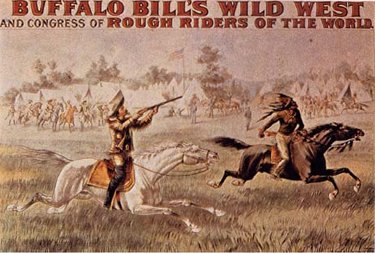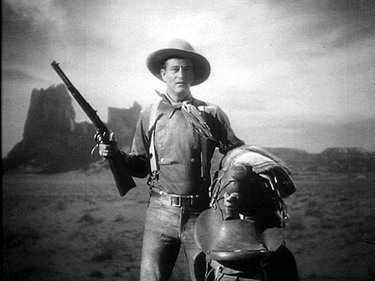“The Scene Had a Problem, and the Problem Was the Gun.”
"Stagecoach" (1939), Buffalo Bill's Wild West, Film, Guns, Hollywood, John Ford, John Wayne, Winchester 1892, Yakima Canutt
Scott Eyman, in his new biography, John Wayne, The Life the Legend, describes the historic source of the iconic gesture in the opening scene of John Ford‘s “Stagecoach” (1939), which ignited Wayne’s career and made him a major star.
The scene had a problem, and the problem was the gun.
Dudley Nichol’s script was specific. “There is the sharp report of a rifle and Curly jerks up his gun as Buck saws wildly at the ribbons.
“The stagecoach comes to a lurching stop before a young man who stands in the road beside his unsaddled horse. He has a saddle over one arm and a rifle carelessly swung in the other hand… It is Ringo…
“RINGO? You might need me and this Winchester, I saw a couple ranches burnin’ last night.’
“CURLY? I guess you don’t understand, kid. You’re under arrest.
“RINGO?(with charm) I ain’t arguing about that, Curly. I just hate to part with a gun like this.
“Holding it by the lever, he gives it a jerk and it cocks with a click…”
John Ford loved the dialogue, which was in and of itself unusual, but the introduction of the Ringo Kid needed to be emphasized. Ford decided that the shot would begin with the actor doing something with the gun, then the camera would rapidly track in from a full-length shot to an extreme close-up — an unusually emphatic camera movement for Ford, who had grown to prefer a stable camera.
Since the actor was already coping with two large props, Ford decided to lose the horse. He told his young star what he was planning to do: “work out something with the rifle,” Ford sais. “Or maybe just a pistol.” He wasn’t sure.
And just like that the problem was dropped in the lap of his star, a young — but not all that young — actor named John Wayne., better known to Ford and everyone else as Duke.
Wayne ran through the possibilities. every actor in in westerns could twirl a pistol, so that was out. Besides, the script specified a rifle cocked quickly with one hand, but later in the scene than what Ford was planning. In addition, Ford wanted him to do something flashy, but it couldn’t happen too quickly for the audience to take it in. All the possibilities seemed to cancel each other out.
And then Yakima Canutt, Wayne’s friend and the stunt coordinator on the film offered an idea. When Canutt was a boy he had seen Buffalo Bill’s Wild West show. As the overland stage raced around the arena, a messenger trailing behind the stagecoach had carried a rifle with a large ring loop which allowed him to spin the rifle in the air, cocking it with one hand. The crowd went wild. Canutt said that it had been done thirty years ago and he still remembered the moment. More to the point, he had never seen anybody else do it.
Wayne sparked to the idea, as did Ford, so they had to make it work. Ford instructed the prop department to manufacture a ring loop and install it on a standard issue 1892 Winchester carbine. After the rifle was modified, Wayne began experimenting with the twirl move as Canutt remembered it, but there was a problem — the barrel of the rifle was too long — it wouldn’t pass cleanly beneath Wayne’s arm.
The Winchester went back to the prop department, where they sawed an inch or so off the end, then soldered the sight back on the shortened barrel.
With that minor adjustment, the move was suddenly effortless. Wayne began rehearsing the twirling movement that would mark his appearance in the movie he had been waiting more than ten years to make — a film for John Ford, his friend, his mentor, his idol, the man he called “Coach” or, alternately — and more tellingly — “Pappy.”
With any luck at all, he’d never have to go back to B westerns as long as he lived.
—————————
—————————

Buffalo Bill’s Wild West and Congress of Rough Riders of the World.
John Ford Westerns, Liberal Lessons?
"The Man Who Shot Liberty Valance" (1962), David Brooks, Film, John Ford, Liberalism, My Darling Clementine (1946)

Tom Doniphon (John Wayne) tells a few hard truths to Ransom Stoddard (James Stewart) in The Man Who Shot Liberty Valence
David Brooks watches John Ford Westerns (apparently only one John Ford Western), and advises us that John Ford movies are all about communitarianism. According to Brooks, John Ford Westerns are paeans to the collectivist statist ideals of Barack Obama and the democrat party.
We Republicans need to register (and then surrender) our sixguns, turn over our poker chips to build a new schoolhouse, hire some government administrators, and then come out to the church social to sing hymns.
Republicans generally like Westerns. They generally admire John Wayne-style heroes who are rugged, individualistic and brave. They like leaders — from Goldwater to Reagan to Bush to Palin — who play up their Western heritage. Republicans like the way Westerns seem to celebrate their core themes — freedom, individualism, opportunity and moral clarity.
But the greatest of all Western directors, John Ford, actually used Westerns to tell a different story. Ford’s movies didn’t really celebrate the rugged individual. They celebrated civic order.
For example, in Ford’s 1946 movie, “My Darling Clementine,†Henry Fonda plays Wyatt Earp, the marshal who tamed Tombstone. But the movie isn’t really about the gunfight and the lone bravery of a heroic man. It’s about how decent people build a town. Much of the movie is about how the townsfolk put up a church, hire a teacher, enjoy Shakespeare, get a surgeon and work to improve their manners.
The movie, in other words, is really about religion, education, science, culture, etiquette and rule of law — the pillars of community. In Ford’s movie, as in real life, the story of Western settlement is the story of community-building. Instead of celebrating untrammeled freedom and the lone pioneer, Ford’s movies dwell affectionately on the social customs that Americans cherish — the gatherings at the local barbershop and the church social, the gossip with the cop and the bartender and the hotel clerk.
Today, if Republicans had learned the right lessons from the Westerns, or at least John Ford Westerns, they would not be the party of untrammeled freedom and maximum individual choice. They would once again be the party of community and civic order.
———————————-
James Bowman, in a posting titled A Ford Not a Lincoln, rebuts nicely adding another John Ford film to the discussion which illuminates the message Brooks misunderstands much more clearly.
In this movie as in others by Ford, particularly The Man Who Shot Liberty Valance (1962), we see both things: both the community and civilization that people, left in peace, will spontaneously create for themselves and the lone man with the gun, free and solitary, whom the community, often without knowing it, depends on to be left in peace. Without the one, there would not be the other. Ford’s point in both movies is that the community will happily discard and exile and finally forget about the hero, once his work is done. Mr Brooks himself unwittingly illustrates it by forgetting about him, or regarding him as incidental material.
In both movies, too, the hero is complict in his own marginalization by the community he saves. He prefers to live apart from it, partly because, in order to do what he does, he belongs more to the savage, honor-bound, heroic world that he helps to supplant. In Liberty Valance, John Wayne’s forgotten hero, Tom Doniphon has far more in common with Lee Marvin’s Liberty (significant name) than he does with Jimmy Stewart’s Ransom Stoddard. Stoddard even marries the woman he, Doniphon, loves, which makes his rescue both of Stoddard and of the world of law and civic order he represents even more of a noble renunciation than it would be in any case. Tellingly, Ford also shows how the town wants to tell itself a false story about Doniphon’s act of murder, in order to bring it under the umbrella of law and civic order which that act has made possible. And those who know the true story — that in the end civilization itself depends on the man with the gun — allow the false one to stand. Ford must have foreseen even in 1964 the time nearly half a century on when people like David Brooks would have forgotten that primal act of heroism that makes everything else possible and so come to believe, like the townsfolk of Shinbone in Ford’s movie, that civilization can bring itself to birth and sustain itself without the need for honor and courage.






